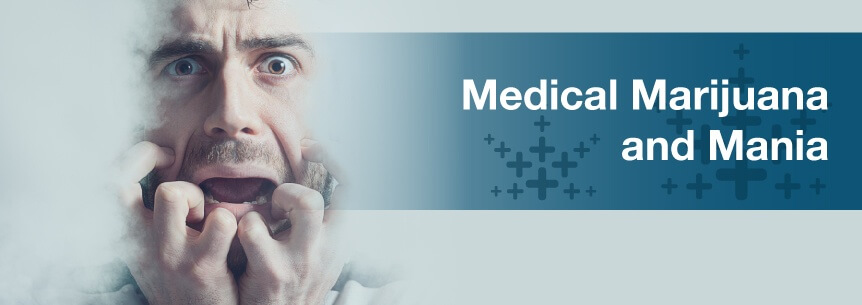
From erratic moods to uncontrollable spending and increased irritation, living with mania can be challenging. Derived from the Greek word for madness, mania can make a person feel like they do not have control over their mind, mood or behavior. Mania can cause a person to have poor judgment or participate in risky behaviors that significantly impact their daily life.
As with many other mood disorders, marijuana can be an effective treatment to relieve the symptoms of mania. Medical marijuana leaves patients with a better state of mental health, emotional health, spirituality and social functioning. Due to the psychoactive properties of cannabis, it can serve as a mood stabilizer to help those who experience episodes of mania.
Mania is an elevated mood characterized by extreme and intense emotions of elation or irritability, high activity and energy levels, racing thoughts and increased speed or volume of speech. Those experiencing mania may have severe insomnia, poor judgment, heightened sexual drive and may behave inappropriately in public. Mania is episodic, meaning a person experiences a distinct period of mania lasting at least a week in which the symptoms of mania are present most days and for most of the day.
True manic episodes are severe enough to interfere with the person’s daily life including dysfunction in the family, disruption of social activities, neglect of responsibilities and problems at work. Often a person must be hospitalized while experiencing a manic episode to protect them from risky behavior.
Mania is most often a symptom of bipolar disorder, which involves high and low mood swings, called mania and depression, respectively. Mania is a defining factor of bipolar disorder — a person with bipolar may experience only manic episodes and periods of normal moods, without any depressive episodes. Mania can also occur in patients with schizoaffective disorder. Episodes of manic behavior can be triggered by certain medications, such as antidepressants and the steroid prednisone. Other triggers of mania in persons with bipolar can include the use of drugs or alcohol, an irregular sleep schedule, sleep deprivation or a very stressful or emotional event.
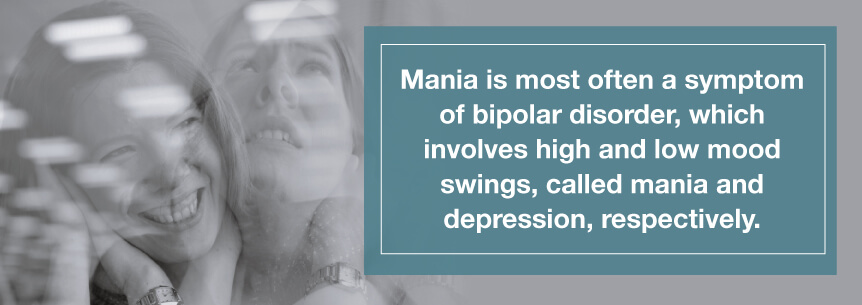
According to the National Institute of Mental Health (NIMH), approximately 4.4 percent of adults in the U.S. will suffer from bipolar disorder at some point in their life. Of these cases, the majority are serious with almost 83 percent of persons experiencing severe impairment and only 17 percent experiencing moderate impairment. Compared to other mood disorders, bipolar presents the highest percentage of severe cases. The prevalence of bipolar disorder is similar between adult men and women, but females with bipolar disorder tend to experience rapid cycling between moods more often and may have more depressive episodes than men.
Among teens age 13 to 18, 2.9 percent have bipolar disorder and 2.6 percent experience severe symptoms. Bipolar disorder is more prevalent among female adolescents than males.
A person experiencing mania will exhibit an abnormally elevated mood accompanied by a variety of symptoms. These symptoms range in severity from person to person. Often it is difficult for the person to realize they are having a manic episode, as they may experience impaired thinking and be unable to recognize their own symptoms. Some common symptoms of mania include:
In very severe cases, mania can lead to delusions or hallucinations. This psychosis can cause the patient to hear or see things that are not there. The patient may believe they have superpowers or superhuman skills, which can cause them to engage in extremely risky behavior. If someone is irritable due to mania, this may develop into paranoid rage. When mania becomes severe, the person suffering may require hospitalization to prevent harm to themselves or others. About 90 percent of individuals with bipolar I disorder require hospitalization at least once during their lifetime and about 66 percent experience two or more psychiatric hospitalizations.
For those suffering from bipolar disorder, periods of mania can sometimes be enjoyable in comparison to depressive episodes. The elevated mood and energy may feel like a relief after long periods of low emotions and lack of energy. However, this poses a particular challenge for those suffering from mania as they are often unable to realize that their mood is too high or that they are acting irrationally or erratically. During these high moods, the patient may engage in embarrassing behaviors, including extravagant spending and participating in poor financial decisions. These actions cause problems in the person’s life even after the manic episode has passed.
Depending on the severity and symptoms, mania can be classified in a few different ways:
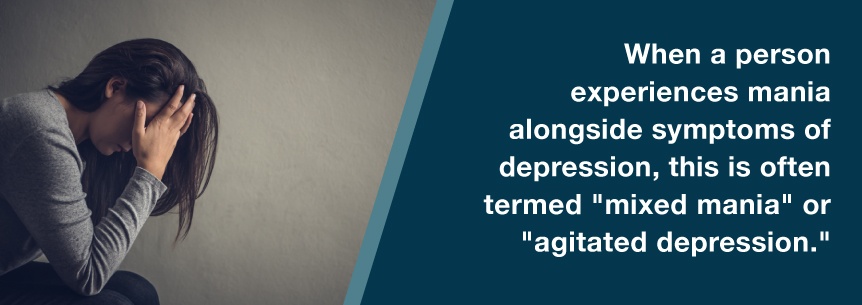
Bipolar disorder typically begins in teenage or young adult years, with 18 being the average age of a first manic episode. It is extremely rare that bipolar disorder is diagnosed for the first time in adults older than 65 or young children. After the onset of the disease, bipolar disorder typically persists for the rest of the patient’s life and is characterized by relapses and remissions. Psychosis and impaired thinking can make it difficult for a person with mania to recognize when they are having an episode, so it is often family members or friends who identify the symptoms or mania.
Diagnosis of bipolar disorder or mania begins with talking to a healthcare professional. A doctor may perform a physical evaluation to rule out other conditions and then conduct a mental health evaluation. The patient will then be referred to a psychiatrist or other mental health professional who is trained to properly diagnose the disease.
Bipolar disorder can be very difficult to diagnose as it is often accompanied by other illnesses, such as anxiety, attention-deficit hyperactivity disorder, eating disorders or substance abuse. Many of the symptoms of bipolar disease also resemble other illnesses. For example, the psychosis which is associated with severe mania can be misdiagnosed as schizophrenia. According to the Depression and Bipolar Support Alliance, only 25 percent of patients receive an accurate diagnosis of bipolar disorder after suffering for less than three years. Many people with bipolar may suffer from symptoms for up to 10 years before their illness is accurately diagnosed.
Mania may also be also be accompanied by heavy substance use or abuse, which can make it difficult for friends or family members to recognize the underlying disease. This can make diagnosing of bipolar disorder difficult as the symptoms of mania and depression may be attributed to drug or alcohol use instead of mental illness.
Mania is currently treated by mood stabilizing medications designed to regulate mood swings and reduce manic symptoms. The most common mood stabilizer for mania is lithium, which is an element that interacts with chemical messengers in the brain. Other mood stabilizers used to treat bipolar include divalproex sodium and carbamazepine. Mood stabilizers are often effective for long-term treatment of bipolar as they may take several weeks to work fully. They have also shown to help prevent future episodes of mania.
For short-term treatment of mania, antipsychotics are often used. These medications are more effective for acute episodes as they can reduce symptoms of mania more quickly. Commonly prescribed antipsychotics include olanzapine, risperidone, and quetiapine. Antidepressants are sometimes used to treat bipolar, especially if the patient suffers from severe depressive symptoms in addition to manic episodes.
When a patient is taking lithium to treat bipolar disorder, they must carefully control their dosage and monitor the levels of lithium in their blood. If lithium levels are too high, the patient may experience side effects such as nausea, dizziness, fatigue, weight gain, thirst, frequent urination, diarrhea and a dazed feeling. Lithium is typically taken twice a day, as a single dose may be more likely to cause side effects. While lithium used to be between 70 and 85 percent successful at treating bipolar, the success rate has dropped to 40 to 50 percent in recent years. Because it must be taken twice daily and accompanied by lab testing, some patients may not enjoy relying on medication to manage their bipolar disorder.
Like with many medications, trial and error is often necessary to find the right dose and type of mood stabilizer to effectively manage bipolar disorder or mania. A patient should report side effects or concerns to a doctor immediately, but should not stop taking the medication without their doctor’s recommendation. If a patient does stop their medication, it may lead to a relapse, withdrawal symptoms or even worse symptoms of bipolar. Changing medications can be a difficult process for the patient as it can cause increased fluctuations in mood and can disrupt the person’s daily life.
When antidepressants are used to treat bipolar, they pose an even greater risk of relapse or complications. Antidepressants can trigger manic episodes and can worsen symptoms of mania when taken to treat mixed mania. Antidepressants may not actually improve the symptoms of depression that a person with bipolar experiences, while potentially worsening their mania.
For those who may not want to rely on medications to treat their mania, there are several lifestyle changes that can reduce symptoms and generally improve daily life. These practices can make living with mania more manageable:
These healthy practices can reduce the symptoms of mania as well as help to prevent future manic episodes. It may also be helpful for a patient to attend therapy or talk with loved ones about their experiences.
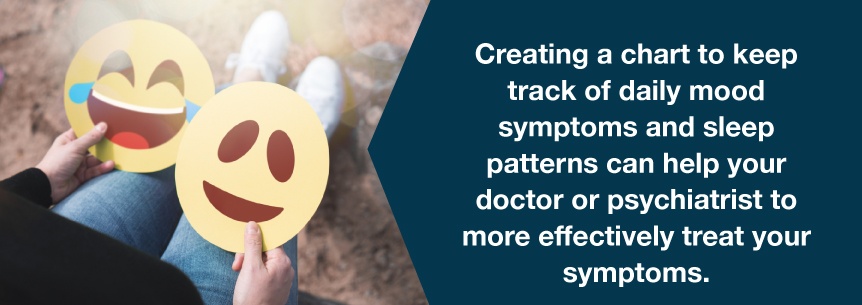
For those who prefer to manage their mania naturally, medical marijuana may also be an effective option. Cannabis has been shown to have anxiety-reducing properties as well as antipsychotic benefits. Using cannabis for mania may help the patient to calm down or relax for better mood stabilization. Marijuana may also provide effective treatment for those whose bipolar is accompanied by other illnesses, such as anxiety or ADHD, as marijuana has been shown to have positive impacts on these diseases.
A 2016 study showed that patients suffering from bipolar disorder experienced alleviation of mood symptoms after marijuana use. The participants in the study reported noticeable mood improvement within four hours of cannabis use, including a decrease in tension, anger and depression. Another important factor revealed by this study is that marijuana did not have an added negative impact on cognitive performance in those suffering from bipolar. Those suffering from bipolar disorder who did not use marijuana experienced the same levels of cognitive impairment as those who did use marijuana. Overall, this study reveals that marijuana use can provide short-term relief from the symptoms of mania without causing impairment.
However, medical research on marijuana and mania is not conclusive, and studies have shown both positive and negative effects of marijuana use in patients with bipolar disorder. A 2015 study showed that marijuana use was associated with an increase in the patient’s positive effect, but also an increase in both manic and depressive symptoms. This study also revealed that participants were more likely to use marijuana when their mood was normal, rather than as a means of self-medicating.
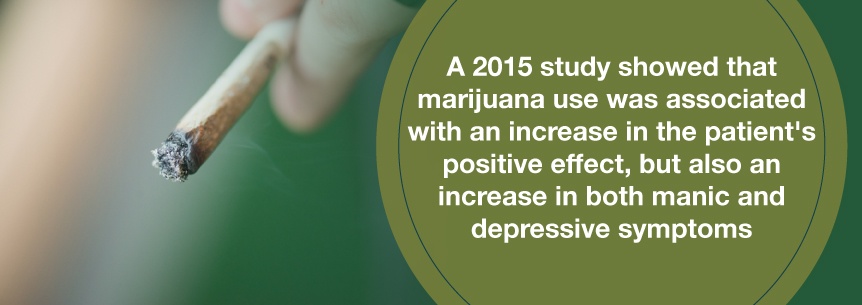
Overall, the benefits of medical cannabis for mania are dependent on the particular patient, as they can be influenced by personality, hormone levels and many other factors. Dosage and mode of use also contribute to the effect of marijuana on a person with bipolar disorder. For this reason, it is particularly important that a person considering medical cannabis for mania treatment consult a doctor to find the proper dosage, strain and ingestion method.
Medical marijuana can provide many benefits for those suffering from mania, including:
While marijuana can provide effective treatment for some people suffering from bipolar disorder, it may also cause negative symptoms or exacerbate symptoms a patient is already experiencing. Possible side effects of marijuana use for mania include:
For some, the possible side effects of cannabis for treating mania may deter them from using marijuana to treat their illness, but for others, medical marijuana may provide a great alternative to traditional bipolar disorder medications.
Finding the right strain and dosage may allow a person living with mania to manage their illness without relying on medication, providing more freedom in their life. Accompanied by healthy lifestyle changes, medical cannabis for mania can provide an effective and natural treatment option. If you are considering marijuana for your bipolar disorder or mania, search for a doctor in your area today. MarijuanaDoctors.com can connect you with a licensed professional to direct you through the recommendation process for cannabis and help you find the right treatment method.
Find A Doctor Find A Dispensary